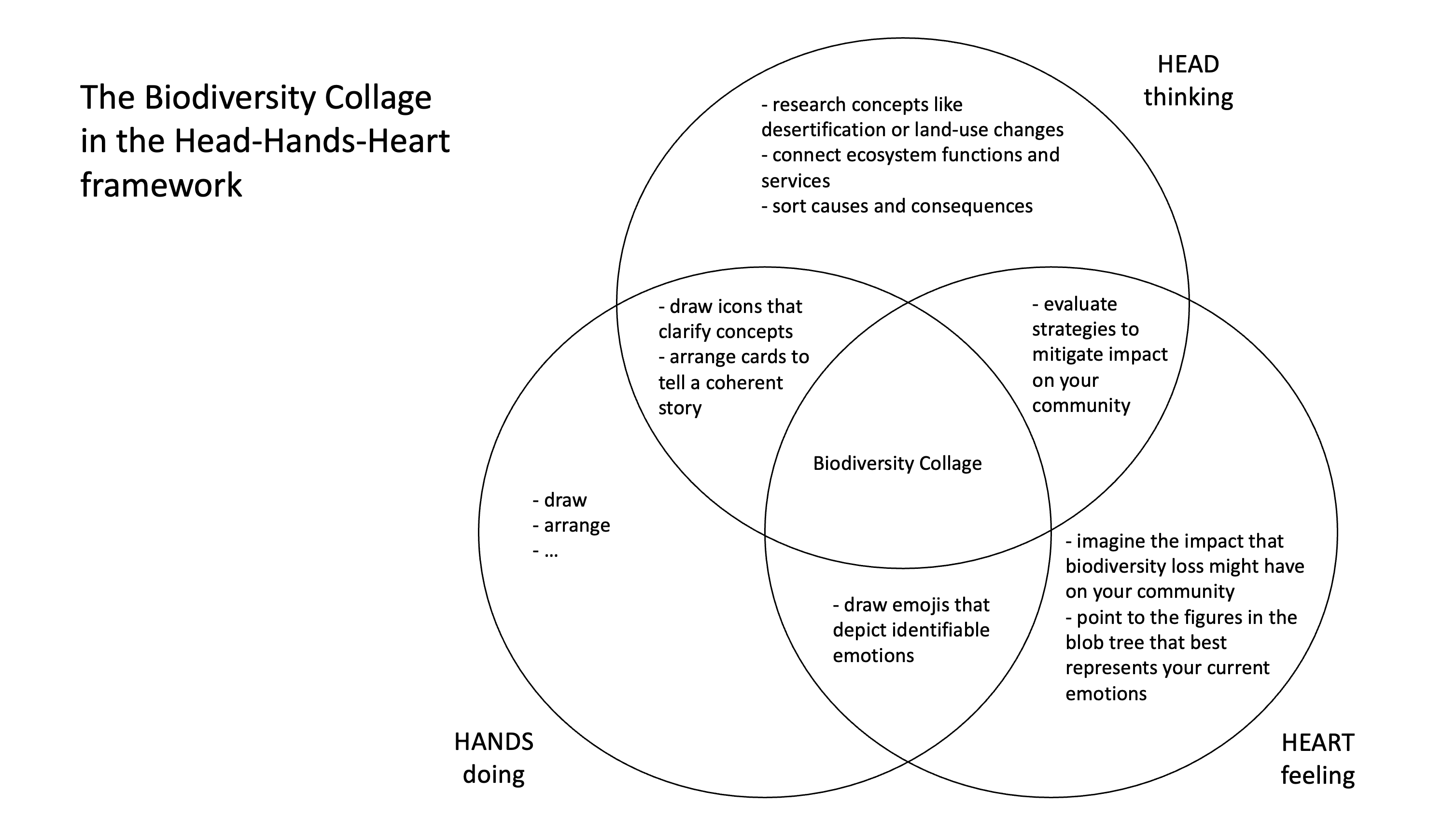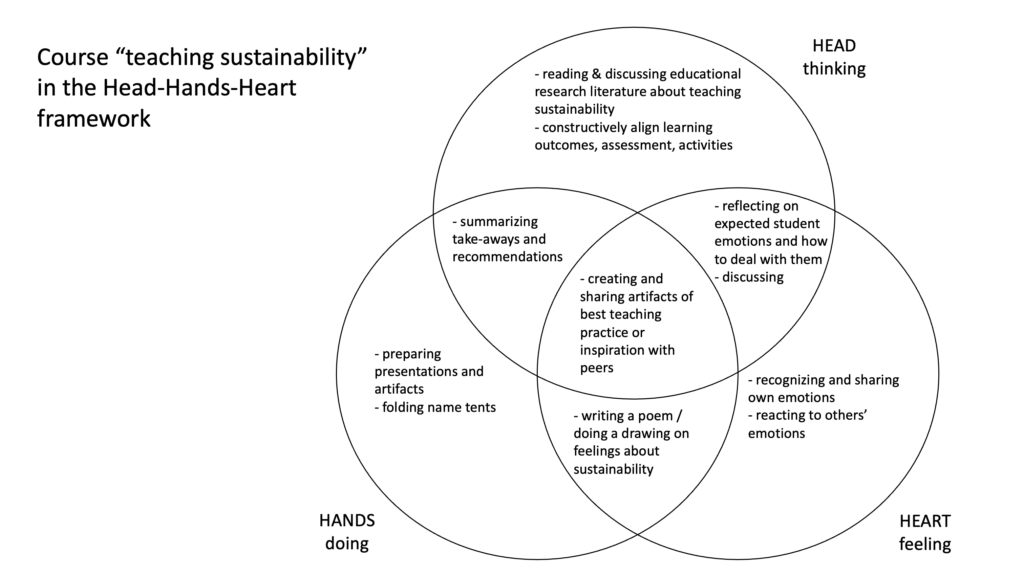
Applying the Head-Hands-Heart framework to my “teaching sustainability” course
As we are getting ready to officially launch our new blog on “teaching about sustainability”, I am revisiting posts on this blog and rewriting them for the different outlet. And one of the first ones I wrote was about the “head-hands-heart” framework. I’m reposting what I wrote for the other blog below, but then I am adding a reflection on how I am actually applying this framework in planning my own course on “teaching sustainability”, starting this spring. Jump to NEW NEW NEW if you are only interested in that part! :-)
One framework that seems to be very helpful when planning teaching about sustainability is the “head, hands, and heart” framework. I am using the term “framework” loosely — it is basically a Venn diagram of three overlapping areas:
- intellectual aspects: the “thinking” part that most of university teaching focuses on and that we as teachers probably feel most comfortable with. Typical activities might be listening to lectures, reading scientific articles, writing reports, solving practice exercises in groups, maybe keeping learning journals
- practical aspects: the “doing” aspects that are a lot less common in most study programs. Maybe there are some skills that are being taught, like using a software to design a poster that efficiently conveys information, building sound structures out of materials that are provided, using specific measurement instrumentation
- emotional aspects: the “feeling” aspects that many teachers try to not get too close to, but that could include for example reflecting on values or how it feels to work in a specific group, learning how to deal with conflicts in group work, or how to motivate yourself to do something you aren’t yet motivated to do
Where these areas overlap, things get a bit more interesting.
- Head and hands combines for example designing and building, reading an instrument manual and operating the instrument, …
- Head and heart combines for example intellectually understanding a topic and translating it into a science poem, designing a questionnaire to figure out what needs a specific community has, …
- Hands and heart combines making something for someone else’s benefit
- Lastly, where head, heart, and hands overlap, students do something that is intellectually challenging and stimulating, but where they also get into the practical implementation of creating a tangible outcome that is connected to a cause and a community they care deeply about. This is what we want to aim for when teaching about sustainability, it is here that the magic is happening, students are engaged and transformed.
This framework was developed by several teams of authors independently of each other and through very different approaches, which only strengthens it in my eyes.
For Sipos et al. (2008), it was a pragmatic approach to integrating sustainability in existing curricula and still achieving transformative learning. They have two premises: 1) Students’ learning is localised, both at university in a formal context, where it is often broken into distinct subjects that are taught completely independent of each other, and in the rest of their lives, i.e. their homes, leisure-time activities, etc. This will lead to conflicts between what is learned in different contexts, unless 2) learning is situated across all those contexts in the first place, and university purposefully integrates all the non-university contexts with the other relevant communities.
Öhman and Sund (2021) develop a similar framework based on educational theories and postulate that sustainability commitment is found where the three areas overlap.
So how can this framework be useful for teachers?
Firstly, just talking about it helps raising the importance of challenging students in more areas than just intellectually, and generating conversations about how this can be done in general and more specifically. Many teachers want to support students in their emotional development and engage them in activities that are meaningful to them, but don’t necessarily feel equipped or allowed to do so.
Then, this framework is helpful as a tool to reflect on our own teaching. If we map all the activities in our course onto the different areas, are there any in the hands and hearts parts, and where the two overlap?
Lastly, it can be very useful to do a similar mapping exercises with planned teaching to check which aspect our focus is on. Most likely the intellectual part, and that’s ok! But maybe there are ways we can and want to add in some emotions or practical aspects? Or, as in the image above that maps the activities in the serious game “Biodiversity Collage” (see here for my event summary), the “hands” part is really not very inspiring. Which is true — there is no artifact being produced that has any impact beyond the workshop itself (except that Léa has done a competition around the best-annotated collage, which she uses throughout the semester as organizer and to put content in the bigger context).
Trying to populate the Head-Hands-Heart Venn diagram is a fun exercise that makes you think about teaching in a different way. Try it and let us know how it goes!
NEW NEW NEW
Now, after having written how people should play with the framework, I continued doing just that myself. In the image below, you see activities that are planned as parts of my “teaching sustainability” course, and then below that I discuss it a bit.

Even though I presented this framework in the first session of my “teaching sustainability” course when I taught it last time, mapping the different activities shows how the biggest part is really in the thinking domain. And that’s not necessarily a bad thing, but it is interesting to note that I had a really hard time thinking about “hands” aspects. Does working on a ppt presentation count? But one thing I came up with that I recommend to every teacher: folding name tents to help students feel that they belong!
On the heart domain, I was planning to make emotions a lot more explicit and give it more planned room. Last course, a lot of discussions touched on teachers’ emotions — stress with the workload, fear of how their students might feel, anxiety about the state of the world — but while we gave it room then, this is something that I want to include much more consciously. I wrote about the Microsoft Reflect tool that I am considering using for the purpose and to model to teachers how to use it in a teaching context, so that is one option. But also writing a poem about feelings about sustainability is an option — I remember that when I was in my #scipoem phase, writing poetry was actually a great outlet of emotions. So maybe I’ll include that? A summary of their project in Haiku form?
But one thing I recognized when working with the framework above, is that for this year, we have actually planned an event where head, hands, and heart come together, and that is opening up the last session to peers. In that last session, teachers will present the projects they’ve been working on during the course, and by doing this in a public setting, they are actually putting a lot of intellectual effort in, but also have the “doing” aspect of packaging it in a presentation, a hand-out, an artifact that they can share with their colleagues, and there is the emotional component of sharing with peers that are there because they have the same interests and concerns as all of us, and the impact that this potentially has on them, their teaching, their students. So really good move, Mirjam! If I say so myself. We’ll see how it goes! :-D
Sipos, Y., Battisti, B., & Grimm, K. (2008). Achieving transformative sustainability learning: engaging head, hands and heart. International Journal of Sustainability in Higher Education.
Öhman, J., & Sund, L. (2021). A didactic model of sustainability commitment. Sustainability, 13(6), 3083.
Summary part 1 of "Competences in Education for Sustainable Development. Critical Perspectives" (Vare, Lausselet, Rieckmann, 2022) - Adventures in Oceanography and Teaching says:
[…] Impacts on pedagogy: if we think about competences as observable behaviours, they should probably not be taught through transmission but rather through experience and practice. And they should not be assessed in atomic pieces of knowledge, skills, etc, but more holistically. Assessment of tiny checkboxes also influences how students see their role, and can hinder them from seeing the bigger picture, taking a stand, becoming who they want to be. An alternative to competences as goals is aiming for a broader “sustainability commitment”, which consists of intellectual, emotional and practical aspects (including competences, just not described in as much detail — this is my favourite head-hands-heart model!). […]
Head-hand-heart: One of our favourite frameworks to approach teaching sustainability – Teaching for Sustainability says:
[…] Venn diagram is a fun exercise that makes you think about teaching in a different way (I share one example of that for my own “teaching sustainability” course on my personal b…). Try it and let us know how it […]